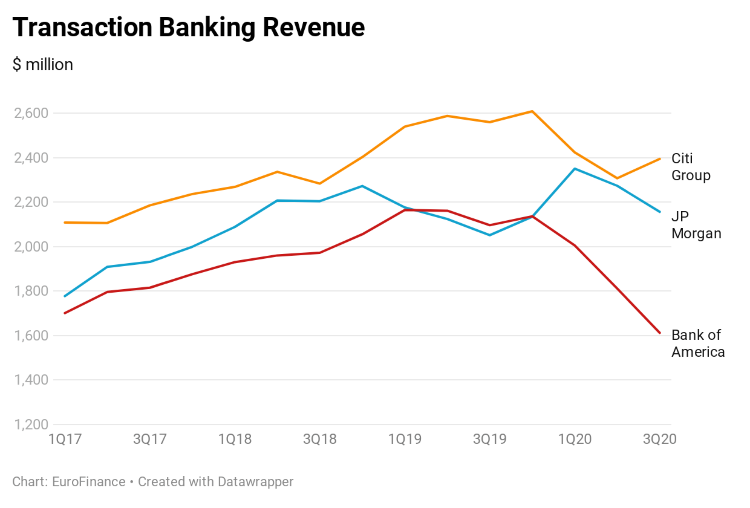US corporate deposits drop in Q3 as loans get repaid

Corporates in the US reduced their cash deposits as they repaid emergency loans in Q3 according to the latest disclosures by US banks.
Six months ago, non-financial companies in the US were drawing down loan facilities and building vast piles of cash for an uncertain Covid-19 future. Now, as the economy recovers, corporates are paying back their loan facilities, either raising cash from capital markets in form of equity and debt issuance, or reducing deposits.
On commercial loans, the top four US banks have reported a drop in Q3 compared to Q2. At the height of Covid-19 pandemic in March, their clients had drawn on revolving credit facilities which meant that loan books of banks increased as well as their provision for credit losses.
In Q3, US banks showed a total reduction of $166 billion in commercial loans from the previous quarter. Bank of America, J.P. Morgan, Wells Fargo and Citigroup saw a reduction of corporate loans by 12%, 9.87%, 9.75% and 6% respectively from Q2 to Q3.
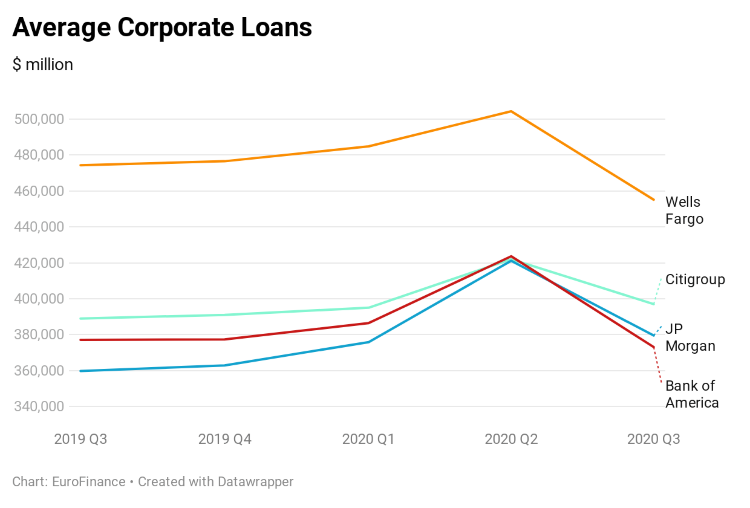
“C&I (commercial and industrial) loans declined $29.2 billion or 8% from the second quarter, driven by higher pay downs, reflecting continued liquidity and strength in the capital markets and lower loan demand, including revolving line utilization, declining to pre-COVID utilization levels, particularly in our middle market business,” Wells Fargo CFO John Shrewsberry said during an investor call.
During the Q3 investors call, factors such as pay down and lower demand for loans were echoed by Paul Donofrio and Jennifer Piepszak who are Chief Financial Officers at Bank of America and J.P. Morgan respectively.
As corporates are shifting away from bank loans to capital markets for equity and debt issuance, this has generated an increase in investment banking fees for banks.
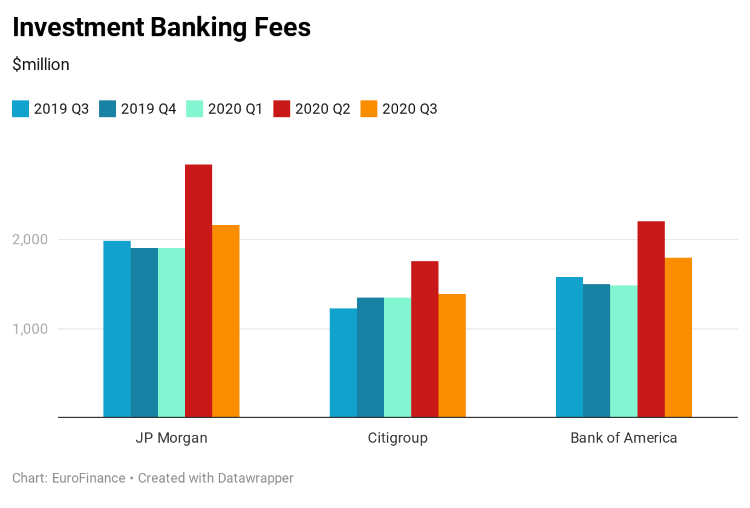
J.P. Morgan, Citigroup and Bank of America saw a decline by 23.9%, 21.1% and 18.2% in its investment banking fees from the previous quarter but a rise of 9.2%, 12.9% and 14.2% year on year respectively.
Citigroup’s CFO Mark Mason noted that “capital markets continued to be extremely strong, equity underwriting, in particular, which allowed us to continue to support our clients in raising liquidity through IPOs, convertibles, and follow-on offerings.”
While J.P. Morgan’s CFO Jennifer Piepszak acclaimed that, “leveraged finance market continued to recover with high-yield spreads approaching pre-COVID levels and some notable acquisition financing deals closing.”
As corporate clients reduced their bank loans and high revenue on investment banking services, banks have been able to lower down the provision on credit losses drastically.
Deposit repayment
Until Q2, corporates had placed $362 billion in form of deposits with banks namely J.P. Morgan, Citigroup and Bank of America which is an increase of 26% from 2019 end but in Q3 this deposit surge reversed direction.
As reported by banks’ in their Q3 2020 financial disclosures, Bank of America and Wells Fargo reported a decline in corporate deposits by $35.5 billion and $29.7 billion respectively while Citigroup’s deposits rose by just a billion dollars. Bucking the trend amongst the top US banks, J.P. Morgan reported an increase of $27 billion in corporate deposits.
The deposit increase in J.P. Morgan came as a surprise even for the bank as was evident from its Q3 investors’ earnings call wherein Chief Financial Officer Jennifer Piepszak said, “On deposits, while we expected to see some normalization in our balances, instead, we saw another quarter of growth.”
The increase is believed to have occurred within the bank’s Wholesale Payments and Securities Services business where clients looked to maintain short term liquidity given the market uncertainty.
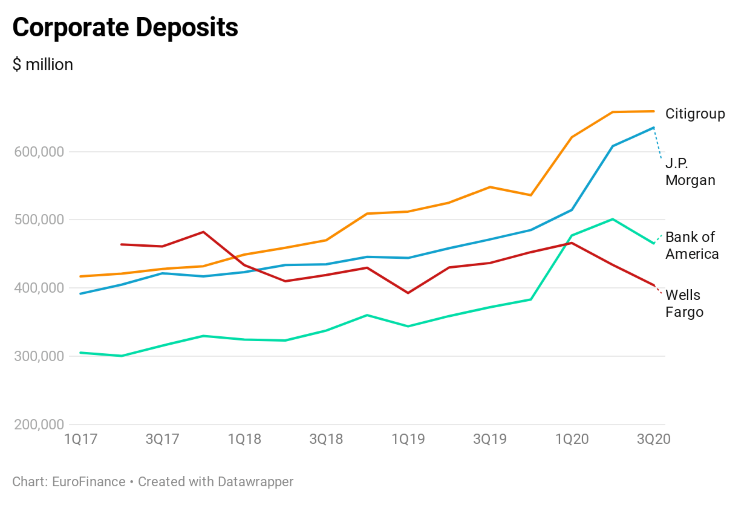
At the end of Q3 2020, corporate deposits held at J.P. Morgan, Citigroup, Bank of America and Wells Fargo stood at $2.16 trillion which is 1.6% less than Q2 2020 but 16% higher than the end of 2019. Of them, Citigroup holds the highest corporate deposits at $659 billion and J.P Morgan comes a close second at $634.9 billion. In terms of YTD, J.P. Morgan registered an increase of $150 billion of deposits.
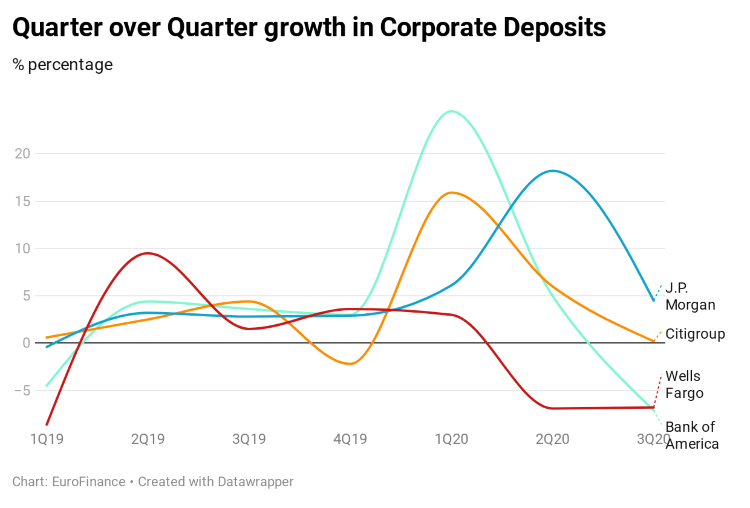
With the corporate deposits at Citigroup being flat from Q2 to Q3, the bank has improved on its treasury and trade solution revenue by 4% from Q2, registering $2.39 billion at the end of Q3 but it was down by 6% year-on-year.
“Treasury and trade solutions, the backbone of our global network, is down only 4% for the quarter and 5% for the year in constant dollars despite significantly lower interest rates,” said Mike Corbat, Chief Executive Officer at Citigroup during investors call.
While J.P Morgan saw a decline in its wholesale payments revenue for straight two quarters, it declined by 5% from Q2 to Q3 due to “deposit margin compression” as stated by bank’s CFO during investors call. Despite a decline of corporate deposits in Bank of America, the bank saw its global transaction revenue decline by 11% in Q3 from the previous quarter.
